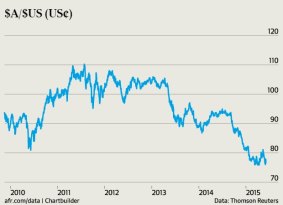This was published 8 years ago
US jobs data, downside risk put pressure on Australian and NZ dollars
By Naomi Tajitsu
The Australian and New Zealand dollars were pressured against the US dollar on Monday after strong US jobs data bolstered expectations for a US interest rate rise before year-end.
The gathering evidence for the US Federal Reserve to start tightening policy comes at a time when the higher yielding commodity currencies are facing more downside risk from possible rate cuts at home.

The Aussie has reversed a rally to US78.19¢, hit last week after the RBA held off from cutting interest rates.Credit: Glenn Hunt
The Reserve Bank of Australia held back from a rate cut last week. However, a struggling domestic economy has investors wagering on an easing before year-end.
In New Zealand, which has been hit by a decline in export prices for its dairy products, such a move could occur as early as Thursday's policy review, some analysts predict.

Losses against the greenback pulled the kiwi down to 74.09 versus a currency basket, its lowest since September 2013.Credit: Peter Rae
"Emerging market currencies have been hit quite strongly on the jobs data, and commodity currencies have been hit as well," Tim Kelleher, head of institutional FX sales at ASB Bank, said.
"On top of that, with the RBNZ [review] on Thursday, the market's going to be cautious on the kiwi."
In subdued trade in Australia, where markets were closed for the public holiday, the Aussie traded around US76.25¢ after easing to US75.98¢ on Friday. The Aussie reversed a rally to US78.19¢, which was hit last week after the RBA held off from cutting interest rates.
The kiwi traded around US70.50¢, wallowing near a five-year low of US70.25¢ hit late last week after the strong payrolls report. Losses against the greenback pulled the kiwi down to 74.09 versus a currency basket, its lowest since September 2013.

In subdued public holiday trade, the Aussie traded around US76.25¢.
Domestic data showing a fall in wholesale trade during the first quarter fuelled speculation that growth in New Zealand's outperforming economy was slowing because, in part, of a slump in global prices for dairy products, the country's biggest export earner.
Signs that demand may ease in the face of persistently low inflation risks have prompted markets to price in a 43 per cent chance that the Reserve Bank of New Zealand may cut interest rates by 25 basis points at this week's meeting.
Mr Kelleher said a rate cut this week may push the kiwi through support at US70.00¢ and down towards US67.00¢.
However, he added that a barrage of bets against the currency on rate cut speculation pushed short positioning to an all-time high, raising the risk of a correction towards US74.00¢ if the RBNZ stood pat.
Emerging market currencies have been hit quite strongly on the jobs data, and commodity currencies have been hit as well.
Tim Kelleher, ASB Bank
New Zealand government bonds fell, tracking losses in US Treasuries and other overseas bonds markets, pushing yield as much as 3 basis points along the curve.
Reuters